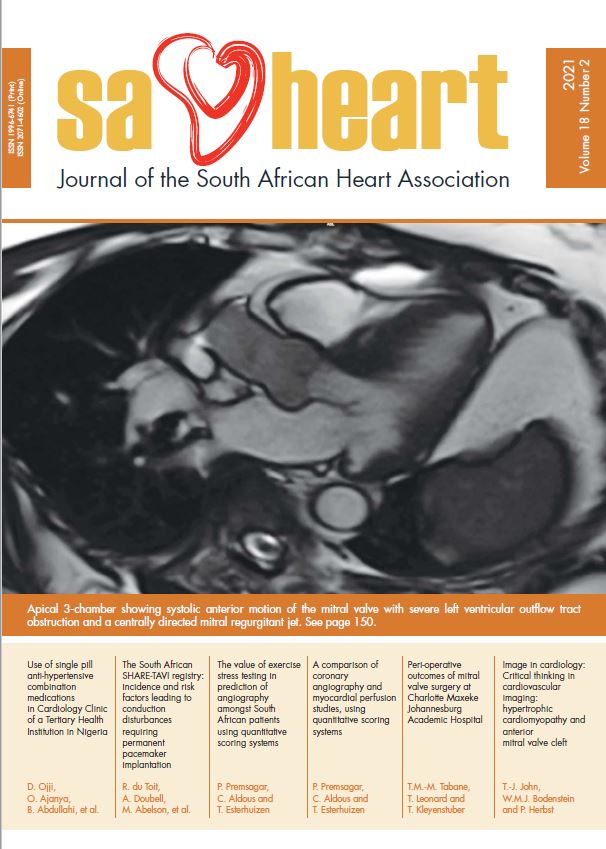The value of exercise stress testing in prediction of angiography amongst South African patients using quantitative scoring systems
Abstract
Background: Accurate pre-test assessment of high risk patients may increase positive yield on angiography. Exercise stress testing (EST) prediction of angiography, may be evaluated by Duke Treadmill Score (DTS), and Synergy between Percutaneous Coronary Intervention with Taxus and Cardiac Surgery (SYNTAX) score, respectively.
Aim: To investigate the value of EST in prediction of angiography amongst South African patients using quantitative scoring systems.
Methods: The DTS and SYNTAX score were compared in patients with high risk pre-test assessments selected for angiography. Logistic regression modelling determined the odds ratio of abnormal angiograms using EST as a predictor.
Results: Pre-test assessment of 525 suspected coronary artery disease patients, indicated angiography in 131 high risk individuals. The positive yield of abnormal angiograms was 58.0%, with no correlation between DTS and SYNTAX scores (Pearson’s correlation coefficient = 0.113, p=0.200). There was low predictive probability on receiver-operator-curve for DTS when compared to angiogram results (area under curve (AUC)=0.529, p=0.574), and SYNTAX categories (AUC=0.432, p=0.378). Chi-square tests had no significance between angiography and EST (all p-values >0.05). However DTS predicted abnormal angiograms with odds ratio of 1.92 when relevant cardiovascular risk factors (smoking, BMI, age) were added.
Conclusion: Pre-test assessment of high risk patients represented a homogenous group with prevalent cardiovascular risk factors. However, the high risk group had no relationship between DTS and SYNTAX scores, indicating DTS alone discounts risk factors. Modelling accounted for DTS limitation by demonstrating an obese, elderly smoker with high risk category DTS is 1.92 times more likely to have an abnormal angiogram.
Copyright (c) 2021 SA Heart Journal

This work is licensed under a Creative Commons Attribution-NonCommercial-NoDerivatives 4.0 International License.
This journal is an open access journal, and the authors and journal should be properly acknowledged, when works are cited.
Authors may use the publishers version for teaching purposes, in books, theses, dissertations, conferences and conference papers.Â
A copy of the authors’ publishers version may also be hosted on the following websites:
- Non-commercial personal homepage or blog.
- Institutional webpage.
- Authors Institutional Repository.Â
The following notice should accompany such a posting on the website: “This is an electronic version of an article published in SAHJ, Volume XXX, number XXX, pages XXX–XXX”, DOI. Authors should also supply a hyperlink to the original paper or indicate where the original paper (http://www.journals.ac.za/index.php/SAHJ) may be found.Â
Authors publishers version, affiliated with the Stellenbosch University will be automatically deposited in the University’s’ Institutional Repository SUNScholar.
Articles as a whole, may not be re-published with another journal.
Copyright Holder: SA Heart Journal
The following license applies:
Attribution CC BY-NC-ND 4.0

